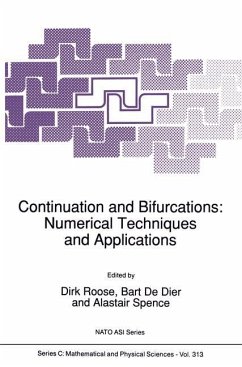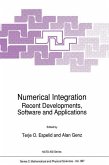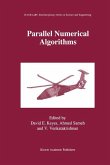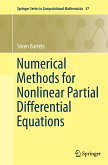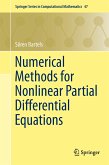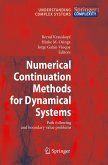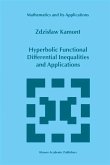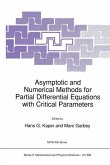Continuation and Bifurcations: Numerical Techniques and Applications
Herausgegeben:Roose, Dirk; De Dier, Bart; Spence, Alastair
Continuation and Bifurcations: Numerical Techniques and Applications
Herausgegeben:Roose, Dirk; De Dier, Bart; Spence, Alastair
- Broschiertes Buch
- Merkliste
- Auf die Merkliste
- Bewerten Bewerten
- Teilen
- Produkt teilen
- Produkterinnerung
- Produkterinnerung
In September 1989, a NATO Advanced Research Workshop on "Continuation and BIfurcations: NumerIcal TechnIques and Applications" was held at the Katholieke Unlversiteit Leuven, Belgium. Participants came from 10 countries in Europe and North America and were mainly from universities and research institutes. This proceedings volume contains 26 of the 38 papers which were presented at the meeting. Abstracts of most other contrIbutions are also included. The central theme of the workshop was the solution of parameter dependent nonlinear problems using numerical continuation. More specifically the…mehr
Andere Kunden interessierten sich auch für
![Numerical Integration Numerical Integration]() Numerical Integration42,99 €
Numerical Integration42,99 €![Parallel Numerical Algorithms Parallel Numerical Algorithms]() Parallel Numerical Algorithms161,99 €
Parallel Numerical Algorithms161,99 €![Numerical Methods for Nonlinear Partial Differential Equations Numerical Methods for Nonlinear Partial Differential Equations]() Sören BartelsNumerical Methods for Nonlinear Partial Differential Equations113,99 €
Sören BartelsNumerical Methods for Nonlinear Partial Differential Equations113,99 €![Numerical Methods for Nonlinear Partial Differential Equations Numerical Methods for Nonlinear Partial Differential Equations]() Sören BartelsNumerical Methods for Nonlinear Partial Differential Equations113,99 €
Sören BartelsNumerical Methods for Nonlinear Partial Differential Equations113,99 €![Numerical Continuation Methods for Dynamical Systems Numerical Continuation Methods for Dynamical Systems]() Numerical Continuation Methods for Dynamical Systems129,99 €
Numerical Continuation Methods for Dynamical Systems129,99 €![Hyperbolic Functional Differential Inequalities and Applications Hyperbolic Functional Differential Inequalities and Applications]() Z. KamontHyperbolic Functional Differential Inequalities and Applications81,99 €
Z. KamontHyperbolic Functional Differential Inequalities and Applications81,99 €![Asymptotic and Numerical Methods for Partial Differential Equations with Critical Parameters Asymptotic and Numerical Methods for Partial Differential Equations with Critical Parameters]() Asymptotic and Numerical Methods for Partial Differential Equations with Critical Parameters166,99 €
Asymptotic and Numerical Methods for Partial Differential Equations with Critical Parameters166,99 €-
-
-
In September 1989, a NATO Advanced Research Workshop on "Continuation and BIfurcations: NumerIcal TechnIques and Applications" was held at the Katholieke Unlversiteit Leuven, Belgium. Participants came from 10 countries in Europe and North America and were mainly from universities and research institutes. This proceedings volume contains 26 of the 38 papers which were presented at the meeting. Abstracts of most other contrIbutions are also included. The central theme of the workshop was the solution of parameter dependent nonlinear problems using numerical continuation. More specifically the aims can be stated as: to descrIbe typIcal bifurcation problems In sclentiftc, engineering and industrial problems; to discuss current mathematical ideas and new developments in numerical analysis and numerical techniques and to describe and evaluate program packages and to discuss future needs with respect to software. The interests of the participants extended over the complete spectrum of theory, numerical analysis, software and applications, and this spread is reflected both in the composition of this volume and in several of the papers. For example, there are contributions on the application of Centre ManIfold and Uapunov Schmidt theory to derive low dimensional systems which can be analysed by normal form theory for dynamical systems or singularIty theory.
Hinweis: Dieser Artikel kann nur an eine deutsche Lieferadresse ausgeliefert werden.
Hinweis: Dieser Artikel kann nur an eine deutsche Lieferadresse ausgeliefert werden.
Produktdetails
- Produktdetails
- Nato Science Series C: 313
- Verlag: Springer / Springer Netherlands
- Artikelnr. des Verlages: 978-94-010-6781-2
- Softcover reprint of the original 1st ed. 1990
- Seitenzahl: 444
- Erscheinungstermin: 28. September 2011
- Englisch
- Abmessung: 235mm x 155mm x 24mm
- Gewicht: 668g
- ISBN-13: 9789401067812
- ISBN-10: 9401067813
- Artikelnr.: 39492236
- Herstellerkennzeichnung
- Books on Demand GmbH
- In de Tarpen 42
- 22848 Norderstedt
- info@bod.de
- 040 53433511
- Nato Science Series C: 313
- Verlag: Springer / Springer Netherlands
- Artikelnr. des Verlages: 978-94-010-6781-2
- Softcover reprint of the original 1st ed. 1990
- Seitenzahl: 444
- Erscheinungstermin: 28. September 2011
- Englisch
- Abmessung: 235mm x 155mm x 24mm
- Gewicht: 668g
- ISBN-13: 9789401067812
- ISBN-10: 9401067813
- Artikelnr.: 39492236
- Herstellerkennzeichnung
- Books on Demand GmbH
- In de Tarpen 42
- 22848 Norderstedt
- info@bod.de
- 040 53433511
Bifurcation to rotating waves from non
trivial steady
states.
Use of approximate inertial manifolds in bifurcation calculations.
Understanding steady
state bifurcation diagrams for a model reaction
diffusion system.
Bifurcations, chaos and self
organization in reaction
diffusion systems.
Eigenvalue problems with the symmetry of a group and bifurcations.
Steady
state/steady
state mode interaction in nonlinear equations with Z2
symmetry.
Symbolic computation and bifurcation methods.
Bifurcation analysis: a combined numerical and analytical approach.
to the numerical solution of symmetry
breaking bifurcation problems.
A computational method and path following for periodic solutions with symmetry.
Global bifurcations and their numerical computation.
Computation of invariant manifold bifurcations.
A method for homoclinic and heteroclinic continuation in two and three dimensions.
The global attractor under discretisation.
The numerical detection of Hopf bifurcation points.
A Newton
like method for simple bifurcation problems with application to large sparse systems.
Aspects of continuation software.
Interactive system for studies in nonlinear dynamics.
LINLBF: A program for continuation and bifurcation analysis of equilibria up to codimension three.
On the topology of three
dimensional separations, A guide for classification.
The construction of cubature formulae using continuation and bifurcation software.
Determining an Organizing Center for Passive Optical Systems.
Optimization by continuation.
Stability of Marangoni convection in a microgravity environment.
Computing with reaction
diffusion systems: applications in image processing.
Bifurcation of Codimension 2 for a discrete map.
Bifurcation of periodic solutions in PDE's: Numerical techniques and applications (abstract).
Bifurcation and chaos in Chua's circuit family (abstract).
Continuation and collocation for parameter dependent boundary value problems (abstract).
Porous medium combustion (abstract).
Block elimination and the computation of simple turning points (abstract).
Bifurcation into gaps in the essential spectrum (abstract).
Application of numerical continuation in aerospace problems (abstract).
Application of a reduced basis method in structural analysis (abstract).
Some applications of bifurcation theory in engineering (abstract).
Higher order predictors in numerical path following schemes (abstract).
trivial steady
states.
Use of approximate inertial manifolds in bifurcation calculations.
Understanding steady
state bifurcation diagrams for a model reaction
diffusion system.
Bifurcations, chaos and self
organization in reaction
diffusion systems.
Eigenvalue problems with the symmetry of a group and bifurcations.
Steady
state/steady
state mode interaction in nonlinear equations with Z2
symmetry.
Symbolic computation and bifurcation methods.
Bifurcation analysis: a combined numerical and analytical approach.
to the numerical solution of symmetry
breaking bifurcation problems.
A computational method and path following for periodic solutions with symmetry.
Global bifurcations and their numerical computation.
Computation of invariant manifold bifurcations.
A method for homoclinic and heteroclinic continuation in two and three dimensions.
The global attractor under discretisation.
The numerical detection of Hopf bifurcation points.
A Newton
like method for simple bifurcation problems with application to large sparse systems.
Aspects of continuation software.
Interactive system for studies in nonlinear dynamics.
LINLBF: A program for continuation and bifurcation analysis of equilibria up to codimension three.
On the topology of three
dimensional separations, A guide for classification.
The construction of cubature formulae using continuation and bifurcation software.
Determining an Organizing Center for Passive Optical Systems.
Optimization by continuation.
Stability of Marangoni convection in a microgravity environment.
Computing with reaction
diffusion systems: applications in image processing.
Bifurcation of Codimension 2 for a discrete map.
Bifurcation of periodic solutions in PDE's: Numerical techniques and applications (abstract).
Bifurcation and chaos in Chua's circuit family (abstract).
Continuation and collocation for parameter dependent boundary value problems (abstract).
Porous medium combustion (abstract).
Block elimination and the computation of simple turning points (abstract).
Bifurcation into gaps in the essential spectrum (abstract).
Application of numerical continuation in aerospace problems (abstract).
Application of a reduced basis method in structural analysis (abstract).
Some applications of bifurcation theory in engineering (abstract).
Higher order predictors in numerical path following schemes (abstract).
Bifurcation to rotating waves from non-trivial steady-states.- Use of approximate inertial manifolds in bifurcation calculations.- Understanding steady-state bifurcation diagrams for a model reaction-diffusion system.- Bifurcations, chaos and self-organization in reaction-diffusion systems.- Eigenvalue problems with the symmetry of a group and bifurcations.- Steady-state/steady-state mode interaction in nonlinear equations with Z2-symmetry.- Symbolic computation and bifurcation methods.- Bifurcation analysis: a combined numerical and analytical approach.- to the numerical solution of symmetry-breaking bifurcation problems.- A computational method and path following for periodic solutions with symmetry.- Global bifurcations and their numerical computation.- Computation of invariant manifold bifurcations.- A method for homoclinic and heteroclinic continuation in two and three dimensions.- The global attractor under discretisation.- The numerical detection of Hopf bifurcation points.- A Newton-like method for simple bifurcation problems with application to large sparse systems.- Aspects of continuation software.- Interactive system for studies in nonlinear dynamics.- LINLBF: A program for continuation and bifurcation analysis of equilibria up to codimension three.- On the topology of three-dimensional separations, A guide for classification.- The construction of cubature formulae using continuation and bifurcation software.- Determining an Organizing Center for Passive Optical Systems.- Optimization by continuation.- Stability of Marangoni convection in a microgravity environment.- Computing with reaction-diffusion systems: applications in image processing.- Bifurcation of Codimension 2 for a discrete map.- Bifurcation of periodic solutions in PDE's: Numerical techniquesand applications (abstract).- Bifurcation and chaos in Chua's circuit family (abstract).- Continuation and collocation for parameter dependent boundary value problems (abstract).- Porous medium combustion (abstract).- Block elimination and the computation of simple turning points (abstract).- Bifurcation into gaps in the essential spectrum (abstract).- Application of numerical continuation in aerospace problems (abstract).- Application of a reduced basis method in structural analysis (abstract).- Some applications of bifurcation theory in engineering (abstract).- Higher order predictors in numerical path following schemes (abstract).
Bifurcation to rotating waves from non
trivial steady
states.
Use of approximate inertial manifolds in bifurcation calculations.
Understanding steady
state bifurcation diagrams for a model reaction
diffusion system.
Bifurcations, chaos and self
organization in reaction
diffusion systems.
Eigenvalue problems with the symmetry of a group and bifurcations.
Steady
state/steady
state mode interaction in nonlinear equations with Z2
symmetry.
Symbolic computation and bifurcation methods.
Bifurcation analysis: a combined numerical and analytical approach.
to the numerical solution of symmetry
breaking bifurcation problems.
A computational method and path following for periodic solutions with symmetry.
Global bifurcations and their numerical computation.
Computation of invariant manifold bifurcations.
A method for homoclinic and heteroclinic continuation in two and three dimensions.
The global attractor under discretisation.
The numerical detection of Hopf bifurcation points.
A Newton
like method for simple bifurcation problems with application to large sparse systems.
Aspects of continuation software.
Interactive system for studies in nonlinear dynamics.
LINLBF: A program for continuation and bifurcation analysis of equilibria up to codimension three.
On the topology of three
dimensional separations, A guide for classification.
The construction of cubature formulae using continuation and bifurcation software.
Determining an Organizing Center for Passive Optical Systems.
Optimization by continuation.
Stability of Marangoni convection in a microgravity environment.
Computing with reaction
diffusion systems: applications in image processing.
Bifurcation of Codimension 2 for a discrete map.
Bifurcation of periodic solutions in PDE's: Numerical techniques and applications (abstract).
Bifurcation and chaos in Chua's circuit family (abstract).
Continuation and collocation for parameter dependent boundary value problems (abstract).
Porous medium combustion (abstract).
Block elimination and the computation of simple turning points (abstract).
Bifurcation into gaps in the essential spectrum (abstract).
Application of numerical continuation in aerospace problems (abstract).
Application of a reduced basis method in structural analysis (abstract).
Some applications of bifurcation theory in engineering (abstract).
Higher order predictors in numerical path following schemes (abstract).
trivial steady
states.
Use of approximate inertial manifolds in bifurcation calculations.
Understanding steady
state bifurcation diagrams for a model reaction
diffusion system.
Bifurcations, chaos and self
organization in reaction
diffusion systems.
Eigenvalue problems with the symmetry of a group and bifurcations.
Steady
state/steady
state mode interaction in nonlinear equations with Z2
symmetry.
Symbolic computation and bifurcation methods.
Bifurcation analysis: a combined numerical and analytical approach.
to the numerical solution of symmetry
breaking bifurcation problems.
A computational method and path following for periodic solutions with symmetry.
Global bifurcations and their numerical computation.
Computation of invariant manifold bifurcations.
A method for homoclinic and heteroclinic continuation in two and three dimensions.
The global attractor under discretisation.
The numerical detection of Hopf bifurcation points.
A Newton
like method for simple bifurcation problems with application to large sparse systems.
Aspects of continuation software.
Interactive system for studies in nonlinear dynamics.
LINLBF: A program for continuation and bifurcation analysis of equilibria up to codimension three.
On the topology of three
dimensional separations, A guide for classification.
The construction of cubature formulae using continuation and bifurcation software.
Determining an Organizing Center for Passive Optical Systems.
Optimization by continuation.
Stability of Marangoni convection in a microgravity environment.
Computing with reaction
diffusion systems: applications in image processing.
Bifurcation of Codimension 2 for a discrete map.
Bifurcation of periodic solutions in PDE's: Numerical techniques and applications (abstract).
Bifurcation and chaos in Chua's circuit family (abstract).
Continuation and collocation for parameter dependent boundary value problems (abstract).
Porous medium combustion (abstract).
Block elimination and the computation of simple turning points (abstract).
Bifurcation into gaps in the essential spectrum (abstract).
Application of numerical continuation in aerospace problems (abstract).
Application of a reduced basis method in structural analysis (abstract).
Some applications of bifurcation theory in engineering (abstract).
Higher order predictors in numerical path following schemes (abstract).
Bifurcation to rotating waves from non-trivial steady-states.- Use of approximate inertial manifolds in bifurcation calculations.- Understanding steady-state bifurcation diagrams for a model reaction-diffusion system.- Bifurcations, chaos and self-organization in reaction-diffusion systems.- Eigenvalue problems with the symmetry of a group and bifurcations.- Steady-state/steady-state mode interaction in nonlinear equations with Z2-symmetry.- Symbolic computation and bifurcation methods.- Bifurcation analysis: a combined numerical and analytical approach.- to the numerical solution of symmetry-breaking bifurcation problems.- A computational method and path following for periodic solutions with symmetry.- Global bifurcations and their numerical computation.- Computation of invariant manifold bifurcations.- A method for homoclinic and heteroclinic continuation in two and three dimensions.- The global attractor under discretisation.- The numerical detection of Hopf bifurcation points.- A Newton-like method for simple bifurcation problems with application to large sparse systems.- Aspects of continuation software.- Interactive system for studies in nonlinear dynamics.- LINLBF: A program for continuation and bifurcation analysis of equilibria up to codimension three.- On the topology of three-dimensional separations, A guide for classification.- The construction of cubature formulae using continuation and bifurcation software.- Determining an Organizing Center for Passive Optical Systems.- Optimization by continuation.- Stability of Marangoni convection in a microgravity environment.- Computing with reaction-diffusion systems: applications in image processing.- Bifurcation of Codimension 2 for a discrete map.- Bifurcation of periodic solutions in PDE's: Numerical techniquesand applications (abstract).- Bifurcation and chaos in Chua's circuit family (abstract).- Continuation and collocation for parameter dependent boundary value problems (abstract).- Porous medium combustion (abstract).- Block elimination and the computation of simple turning points (abstract).- Bifurcation into gaps in the essential spectrum (abstract).- Application of numerical continuation in aerospace problems (abstract).- Application of a reduced basis method in structural analysis (abstract).- Some applications of bifurcation theory in engineering (abstract).- Higher order predictors in numerical path following schemes (abstract).

